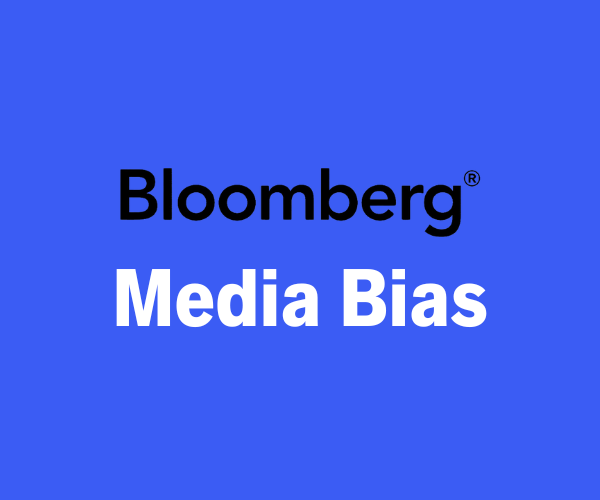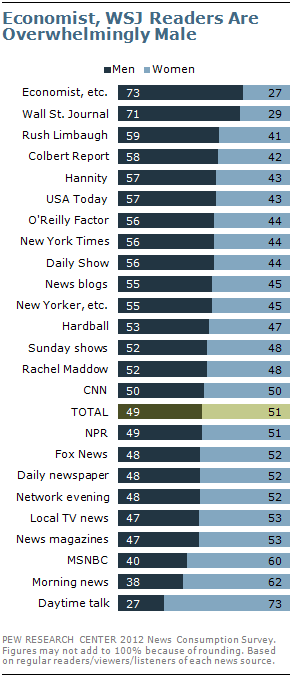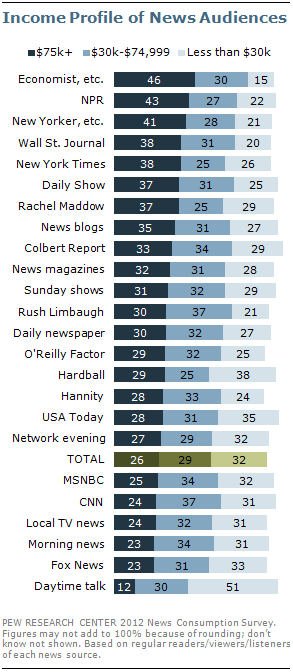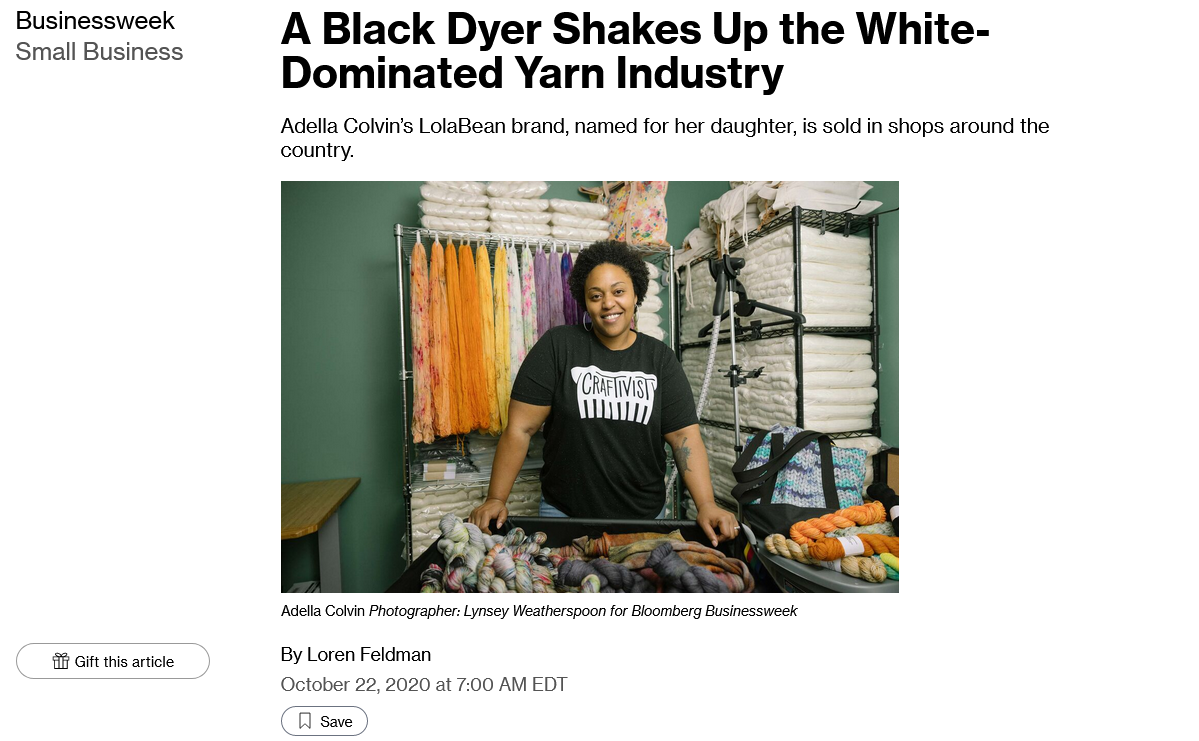
Bloomberg.com is the online footprint of Bloomberg News (formerly Bloomberg Business News), the media division of Bloomberg L.P. Founded in 1990 in New York City. Bloomberg News is an international media agency with a global audience covering various issues. It primarily focuses on business and economic news, with articles and news targeted to financial professionals and investors.
With its stated focus on business interests, evaluating whether Bloomberg is a biased media source requires careful scrutiny. According to Pew Research, 73% of the regular readers of Bloomberg Businessweek are male, and 63% of that readership is college-educated. This data matches Pew’s other information regarding the readership of publications with financial orientations, including the Economist and the Wall Street Journal.

Source: Pew Research
In this article, we will investigate whether Bloomberg’s coverage and editorial process allow us to glean any information about possible biases in their output. Our goal at Biasly is to provide a framework that allows for objectively determining bias. Using these tools, we hope to illuminate the extent to which Bloomberg is biased and educate audiences on how media bias manifests itself.
How does Biasly Rate News Sources?
Biasly’s algorithms produce bias ratings to help provide multiple perspectives on issues. Using our A.I. technology and team of political analysts, Biasly has analyzed 200,000+ news articles from more than 3,200 news sources to find the most factual, unbiased news stories.
Biasly determines the degree of political bias in news sources by using Biasly’s Bias Meter Rating, in which Biasly’s team analyzes media sources’ reliability and bias and produces three scores: a Reliability Score that measures the accuracy of media sources; an A.I. Bias Score, evaluated by A.I.; and an Analyst Bias score evaluated by political analysts. These scores are rated based on seven rating metrics, including Tone, Tendency, Diction, Author Check, Selection/Omission, Expediency Bias, and Accuracy. These metrics help our analysts to determine the political attitude of the article.
Our A.I. machine-learning system employs natural language processing and entity-specific sentiment analysis to examine individual articles and determine their bias levels. By analyzing the key terms in an article, such as policies, biased phrases, political terminologies, politicians, and their nicknames, the algorithms can rate the text’s attitude. Bias scores range from -100% to 100%, with higher negative scores being more liberal, higher positive scores being more conservative, and 0% neutral.
Is Bloomberg News Politically Biased?
Biasly’s rating for Bloomberg News is derived from two scores: those based on the determinations of its media analysts and a score produced by A.I. If we consult the rating, we can see that Bloomberg was accorded a Computer Bias Score of Somewhat Liberal to Left-Center and an Analyst Bias Score of Center. These scores are formed from aggregate reviews of 15 articles, each viewed through the lens of one liberal, one moderate, and one conservative-leaning analyst. The more articles that undergo analysis, the more refined the score becomes. Bloomberg News’ results indicate that it tends to take a centrist or neutral position, a reflection, perhaps, of an attempt to avoid discussion of direct political issues and focus on business, economic, and financial news.
Before we begin, we need to discuss bias. Bias is a natural function of humans, and we can express it both consciously and unconsciously. It is one of the most fundamental forms of pattern recognition in humans. This isn’t to lower the bar and say, “All things are biased,” but to explain the process by which we may come to trust specific news organizations that display certain patterns of coverage.
On the media’s part, there is an incentive to retain audiences, encourage them to purchase subscriptions, and rate products positively. Bias is a two-way street; people want to see news stories about things they care about, and the media news views to continue their operations. This creates a positive feedback loop that influences which stories are covered and from what perspective. This also explains the actions of more liberal news organizations.
Analysis of Bias in Bloomberg News Online Articles
If we extrapolate from the Pew Research survey mentioned earlier in the article that the readership of Bloomberg mirrors that of similar outlets like the Economist, the Wall Street Journal, and the Financial Times, we find that the primary audience of Bloomberg tends to be between the ages of 25 to 45, is politically knowledgeable and engaged, and is highly educated, with an income level that Bloomberg Media themselves claim is one of the highest among all media audiences in the world. The 2021 Bloomberg Media audience spotlights show converging interests for their audiences, with financial news of prominent interest to both C-suite executives and the audience with a yearly income of over $250,000.
In terms of political ideology, Pew Research has found that the readership of these outlets generally tracks with those of the general public. They prefer their news without a political slant, including 63% of Wall Street Journal readers and 73% of those who read the Economist. Supposing that the readership of these outlets is similar to that of Bloomberg, we can infer that Bloomberg’s readers also shy away from news with a political slant, which explains why they would be attracted to a source that trumpets its impartiality.

Source: Pew Research
When determining the level of biased content in a piece, our analysts use several metrics: Tone Diction, Author, Tendency, and Expediency Bias, defined as follows:
- Tone represents the attitude of the writing or the emotional content of the piece, distinct from but related to the author’s diction or word choice.
- Diction is the specific words the writer uses or tends to use
- Author is a metric that accounts for the author’s personality and biases; it includes the opinions of the author on various issues based on past articles they have written and social media posts they have made.
- Tendency measures how consistently an author maintains a specific tone or perspective.
- Expediency Bias is the pure surface-level interpretation. It focuses on the immediate impression created by the article’s headline and any images or summaries that may be included.
The first article we will examine is titled “A Black Dyer Shakes up the White-Dominated Yarn Industry.” Biasly rates this article as “Very Liberal” because it echoes progressive orthodoxy on discrimination within the small business space. The tone of the article is clear and insistent, as the author claims that the yarn industry has become an “unlikely cultural battleground… divided by charges of racism and cultural appropriation.”
This article’s sources also reflect the author’s tendency to favor viewpoints that endorse typical progressive positions on the effects of racism in society.
“People say, ‘I had no idea there was so much racism in knitting.’ Colvin says. “Of course. Racism is built into the fabric of our country.”
The diction of the article is harsh and generally aligns with said progressive view:
“The woman who once tried to hide her Black face says she has lost the little bit of filter she had left. “Sometimes I’m brutal… If that makes you not want to buy my yarn, don’t… I’m not going to make middle-aged White women comfortable about where they buy their yarn.”
Due to the selection of such quotes as these, even though the author may not have intended it this way, the diction of the article and its tone reads as very harsh; the language is adversarial and blunt, which may have been the result of the author’s choice of sources. The article was, therefore, found to be generally left-leaning, as the quotes that the author chose paint a particular picture.
For similar reasons, we would rate the article as “Very Liberal” when it comes to Tendency because it maintains its progressive tone consistently throughout the piece; all of its sources focus on this one particular perspective of a “Black Dyer” in the “White-Dominated Yarn industry” and the tension that arises from the interactions between the two groups.
“The industry’s cultural battles peaked in 2019 when Ravelry, long knitting’s dominant social platform… ignited a skirmish by banning all pro-Trump content… ‘We cannot provide a space that is inclusive of all and also allow support for open white supremacy,’ the owners announced in a written statement”.
“The crossfire prompted many knitters of color to share their stories of racism in the industry for the first time.”
“The cries of White privilege were immediate, no doubt influenced by the location of Berg’s store just blocks from where George Floyd was murdered…The video came down, and Berg apologized… ‘I’ve changed from being the loudmouthed leader to listening and learning,’ he says.”
Finally, we can see expediency bias at work in “A Black Dyer Shakes Up the White-Dominated Yarn Industry” by looking at the article headline.

The article primes the reader to view the issue in a particular way immediately; the yarn industry is painted as white “dominated” and the emergence of producers of color is described as a kind of outsider force. The author quotes a source as claiming that her race affected the market for her product:
“When I started selling (yarn), I would not show my face. If people see a Black face, they think ‘inferior’”.
We can see just from the headline and the first few paragraphs that the author understands how an article can be constructed in a manner that encourages those with particular viewpoints to engage with it; those who favor the progressive view on race and racism in society are more likely to read articles which reinforce their viewpoint, and the author is deliberately not trying to push back on that perspective but to encourage a particular interpretation of events.
As for the author’s history, Loren Feldman’s Twitter profile does not reveal much about the author’s personal opinions. He seems to focus exclusively on reporting about small businesses, having also published for Forbes, Inc., and Time, and as the 21 Hats blog and podcast host. The biases in this article may be outliers and not representative of Mr. Feldman’s general views. However, he has occasionally promoted content on the intersection between small business and social issues.
‘The rule is simple and appropriate. Anyone who owns 20 percent or more of a company must personally guarantee an SBA loan. If you think about it, if the U.S. taxpayer is guaranteeing the loan, the entrepreneur should also.’ — @amikassar, @multifunding https://t.co/OzWhNZ3MWE
— Loren Feldman (@lfeldman) July 28, 2023
‘For so long our community has been defined by this model minority myth, of being quiet, or docile, or submissive, and we really just wanted to give a middle finger to that.’ https://t.co/LHRDlruwPj
— 21 Hats (@21_Hats) March 7, 2022
Articles can vary widely, however, even within the same organization, which is why Biasly can rate Bloomberg as being in the Center-Left overall. It is, therefore, paramount that one always be aware of the signs of bias (including, but not limited to, tone and diction) in any media. For a contrasting example, consider this article from Bloomberg News Opinion, which demonstrates little to no bias: “Blue Collars have Outpaced White Collars in Pay- at First Glance”.This article elaborates on a chart in a Bureau of Labor Statistics report, which claims that the average wage has risen faster among blue-collar, lower-wage workers than white-collar workers. In the author’s view, the chart misses out on some critical information, which he then supplies:
“In a sense, both the EPI (Economic Policy Institute) and Yardeni (Edward Yardeni, founder of Yardeni Research Inc.) are correct…”
“Although the numbers in (the chart) are derived from Bureau of Labor Statistics data, you won’t find them on the BLS website. The BLS doesn’t report average hourly wage for higher-wage workers.”
The article uses accurate and reliable sources, namely the Economic Policy Institute and the federal Bureau of Labor Statistics; the language is neutral and sticks to quibbles with individual data points.
The language employed shows that the author is striving to be diplomatic and to apply their analysis to improve upon an already existing piece of information. The language is not adversarial or antagonistic. This is about as neutral an article as you will find.
Analysis of Bias in Bloomberg News Opinion Articles
Disclaimer: there is a clear distinction between reporting and opinion pieces. Quality factual reporting attempts to take a neutral tone, often stating what occurred and supplying data and quotes from primary sources for the reader to form their own opinion. Editorials and opinion pieces, however, are explicitly for columnists to express their personal views. A reliable source will generally include a disclaimer that the opinions expressed in the article do not necessarily reflect those of the source’s editorial board or anyone apart from the author. Despite Bloomberg News’ reputation as a primarily neutral publication focused on the financial sector, it has an Opinion section like many other mainstream news outlets, in which columnists are free to publish their views as they see fit.
Consider the piece “DeSantis’ Immigration Stunt Didn’t Go Entirely as Planned.” Right away, we can see that the language of the title is loaded with bias, calling Gov. Desantis’ actions a “stunt,” which is the kind of acerbic language designed to prime the reader’s opinion before they even consider the body of the article. The attentive reader can see that the author does not intend to provide a balanced viewpoint. Further on in the article, one finds choice items like the claim that:
“(Gov. Desantis) consumed so much media attention that even communities far from the border now irrationally consider illegal immigration as a critical threat to their well-being… instead of the governing failure that it is”.
The author provides no evidence to support their assertion that illegal immigration is the result of a failure of governance or arguments against the idea that illegal immigration is not a critical threat. The important thing to remember is that, like anyone who writes an opinion piece, the author comes to the writing process with a host of their own biases and preconceived notions, which can affect the content.
However, there are ways to produce opinion pieces that mask their biases or produce more objective content. Such pieces can contain suggestions or policy prescriptions that can cloak themselves in relatively neutral language. For an example of this in Bloomberg, see the article “America is a House Divided. Public Service Can Fix It.” This article’s slant and language are pretty diplomatic. It argues that the divisions in American civil society are due in no small part to the lack of proper role models in office.
“Both sides of the political spectrum are at fault (for) hyper-partisan screaming matches.”
The author stresses that a more vital civic spirit and political unity are crucial for America to face the challenges ahead of it, including foreign and domestic security threats. To achieve this, both citizens and political leaders must do their part. He notes that increasing numbers of Americans do not identify with either party, claiming that a recent poll (which he unfortunately does not cite) shows that 43% consider themselves independents. The author explicitly searches for ways to represent this data in the political process and ends with a call for unity.
“We should collectively discuss ways to realign the political process in a way that encourages compromise, bipartisanship and rational discussion.”
Even looking at tone and diction alone, this article is more balanced than the other example.
Who Owns Bloomberg News?
Bloomberg News is the media division of Bloomberg L.P., a privately held financial, software, data, and media company founded by businessman and philanthropist Michael Bloomberg in 1981; he is still the company’s President and CEO. Bloomberg has a long history of political activity, having served as the mayor of New York City from 2002 to 2013 and most recently running for the Democratic nomination for the 2020 presidential election. As the majority owner of a privately held media company, it is natural to assume that Bloomberg’s political values are reflected in his organization’s culture, the staff that Bloomberg hires, and the articles that Bloomberg News chooses to publish.

Source: Wikipedia
Bloomberg News has faced some criticism related to Michael Bloomberg’s political activities. Before the 2020 presidential primary began, Bloomberg News Editor-in-Chief John Micklethwait circulated a memo to the editorial staff that Bloomberg News would refrain from investigating Michael Bloomberg and his political rivals, stating that:
“We will continue our tradition… of not investigating Mike (and his family and foundation),”
In a gesture of magnanimity, the editorial board stated that they would cover Bloomberg’s candidacy in the same manner as they would any other candidate, vowing to treat all involved with the same impartiality.
“We will extend the same policy to his rivals in the Democratic primaries. We cannot treat Mike’s democratic competitors differently from him”.
However, some critics have derided such a move. They point out that the directive does not define “investigation” very clearly. If it is followed as written, Bloomberg would not cover any Democratic candidate in the race with any particular thoroughness. In this instance, this impartiality veers dangerously toward indifference, which would endanger the integrity of Bloomberg News’ coverage.
“… (It) amounts to forcing a political directive on the editorial staff… If huge portions of the political landscape are closed off to reporters by fiat, none of their reporting in any other direction can be legitimate…. Bloomberg readers and viewers will have no idea what facts and narratives are being left out of coverage.”
This directive has even gotten Michael Bloomberg in hot water with former staffers, who are on record claiming that these rules relegated his political writers to “stenography journalism.”
It can often be difficult to tell if the news you watch is biased. If you have settled on a news channel, it’s usually because you trust the information you are gaining. Unfortunately, many trust the information they are hearing because it confirms what they already believe. This is referred to as “confirmation bias.” It is important to challenge your beliefs and get third-party verification that what you are hearing is the full story. This is why we recommend using Biasly to compare different news stories side-by-side using our bias ratings to figure out what both sides think of a political issue.
While Biasly’s analysts found Bloomberg News to trend towards “Left-Center,” each piece published will lean further towards one side of the political spectrum or the other. Regardless of Bloomberg’s focus on business and economics and its general reputation as a newspaper about the financial markets, it is essential to recognize that its coverage addresses a wide range of topics. It publishes pieces on arts and culture, technology, and political issues. In addition, different articles will, by nature, contain more or less bias than others.
Opinion pieces will have more bias than regular news articles because they contain the opinions of a particular author. This fact is always carefully noted by disclaimers on reputable news sources. When evaluating news, one should never forget that news, like all human endeavors, will be marked by bias to some degree. That said, some news outlets stick to the essential facts better than others, which is why, in addition to their discerning judgment, wise consumers are advised to use Biasly’s News Check to help them evaluate the bias in what they read.






















